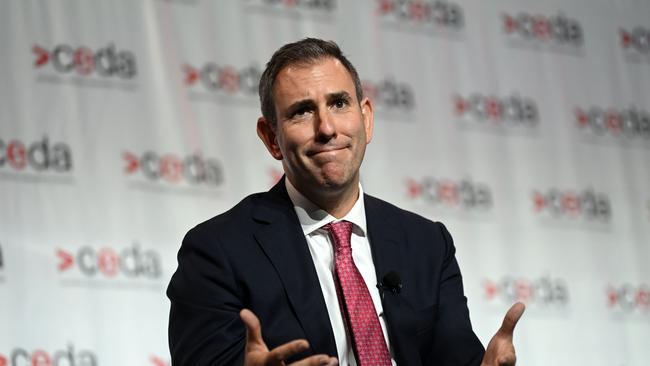
I’m not even sure that trying to scare the daylights out of people, as Treasurer Jim Chalmers did last week, is the way to go. All that talk about the working week being 5 per cent longer and incomes lower by 40 per cent in 2063 if Australia’s productivity trajectory remains on its current course surely simply washes over most people. Who cares about 2063 when it’s a struggle to pay the mortgage and bills this month?

The latest five-year productivity report was released last week by the Productivity Commission. Entitled “Advancing Prosperity”, the report is nearly 1000 pages in length and contains 29 reform directives and 71 specific recommendations. Whether or not this output is an example of productivity can only be judged by the readers, which, I’m guessing, will be very few.
Let me be upfront: I am not a fan of the reform shopping list. It’s not the fault of the PC that the report contains one because that was the request made by government. But the length of the list, and the often superficial analysis that underpins it, mean it is very easy for any government to ignore it or, possibly worse, pick and choose.

Many of the PC recommendations only make sense if they are part of a package of measures. Take the suggestion that the safeguard mechanism, which is designed to reduce carbon emissions, cover many more enterprises by lowering the threshold only makes sense if all the other interventions (bans, taxes, subsidies and the like) designed to reduce emissions are eliminated.
Since this isn’t going to happen it’s entirely possible the PC’s recommendation could actually make matters worse. It’s called the theory of the second best and the PC commissioners are fully aware of it. The dream of securing net-zero emissions at least cost would remain a dream.
A more general point about the shopping-list approach to productivity improvement is the emphasis it places on what governments should do rather than on what governments should not do. There is far too little discussion about governments getting out of the way, by allowing individuals to set up businesses without incurring massive regulatory costs and seeing workers moving to jobs that are the best fit for their skills and aptitudes.

The macro figures are clear on this issue: we have become a country in which the establishment of new businesses has stalled and that workers now stay longer in their current jobs than was once the case. Both these factors are a drag on productivity growth. We should be arguing the case for governments getting out of the way, rather than implementing yet another expensive and ineffective program.
There is some sensible material in the PC report, although quite a lot of it is self-evident However, one could ask, for instance, given all the government money that has been spent on schools, university and vocational education, why we don’t have a skilled and adaptable workforce already.
Some of the background material is also valuable. While our productivity performance has fallen away over the past two decades, in particular, there are some sectors of the economy that have continued to power ahead, including mining and agriculture. The PC report therefore concentrates on these hard sectors, with the service economy now making up over 80 per cent of the total.
The conclusion of US economist, Ben Jones, is favourably quoted: “GDP and future progress depend less and less on the sector we have found relatively easy to advance … and increasingly on the sectors that continue to be hard, which make up a growing share of the economy.”

It is important to note here that Australia is not alone in experiencing a slump in productivity growth: it is evident in most developed economies, including the US, which most people would regard as having a dynamic economy.
Indeed, Robert Gordon, an economist from Northwestern University, maintains that developed economies reached the peak of their productivity growth potential around a century ago and it’s likely to be slow going from here. For him, the rollout of electricity and the diffusion of new technologies were the keys to the very strong productivity growth at that time. He can find no parallels today, even in digital technologies. Needless to say, Gordon’s ideas have created considerable debate and the advocates of digital technologies and artificial intelligence often talk about a new nirvana. But it’s difficult to detect any economy-wide productivity gains from the internet, for instance.
The one area the federal government is bound to ignore from the get-go is the PC’s recommendations about reforming industrial relations regulations, having made up its mind re-regulation of the labour market is in keeping with its political philosophy. In fact, the PC had already expressed grave reservations about any shift to multiemployer bargaining as an obvious drag on productivity as firms are roped into one-size-fits-all arrangements.

The PC recommendations cover both awards and agreements. They are reasonable enough, even if they are unlikely to be considered. The idea that awards are far too complex and prescriptive is obvious, but there has been no real progress over many years in simplifying awards to make them fit for purpose.
The best outcome for the PC report is that it can become a resource for governments and bureaucrats to dip into when policy issues are being discussed. It’s unlikely to have any immediate impact, in part because our historically high terms of trade have protected us from the living standard-sapping impact of sluggish productivity growth. Should the terms of trade nosedive, however, a very different conversation could ensue.








If you ask most people what productivity means to them, they reply that it’s about working harder. It’s one of the reasons productivity doesn’t lend itself easily to political solutions even if productivity is a much simpler idea about the relationship between inputs and outputs and the foundation of our living standards.